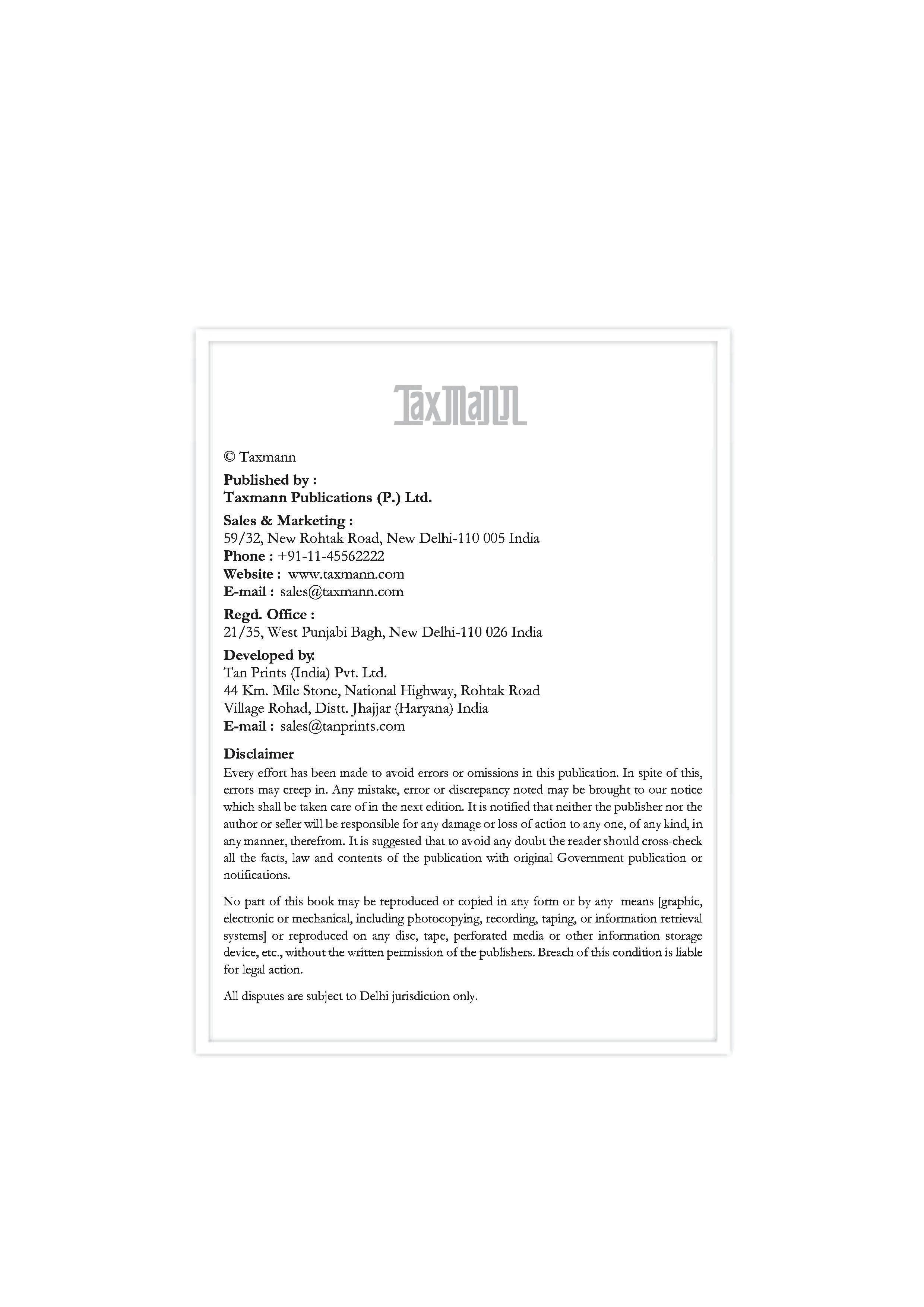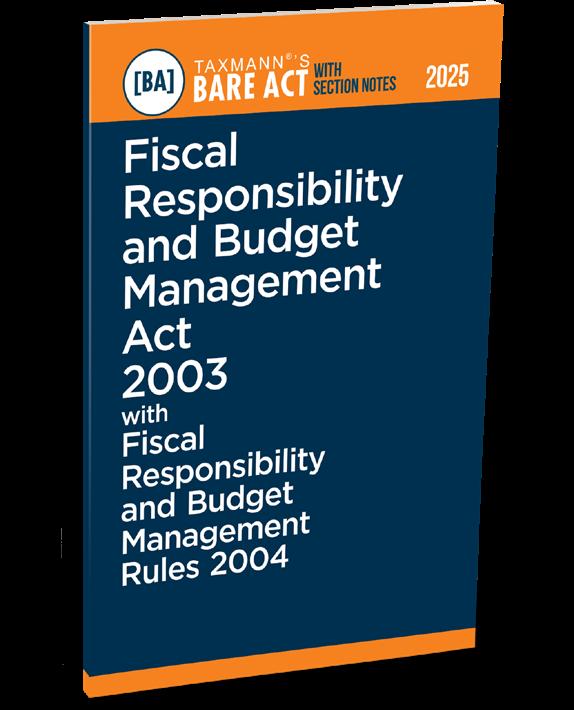


















An Act to provide for the responsibility of the Central Government to ensure intergenerational equity in fiscal management and long-term macro-economic stability by 2[***] removing fiscal impediments in the effective conduct of monetary policy and prudential debt management consistent with fiscal sustainability through limits on the Central Government borrowings, debt and deficits, greater transparency in fiscal operations of the Central Government and conducting fiscal policy in a medium-term framework and for matters connected therewith or incidental thereto.
BE it enacted by Parliament in the Fifty-fourth Year of the Republic of India as follows:—
Short title, extent and commencement.
1. (1) This Act may be called the Fiscal Responsibility and Budget Management Act, 2003.
(2)It extends to the whole of India.
(3)It shall come into force on such date3 as the Central Government may, by notification in the Official Gazette, appoint in this behalf. Definitions.
2. In this Act, unless the context otherwise requires,— (a)“fiscal deficit” means the excess of total disbursements, from the Consolidated Fund of India, excluding repayment of debt, over total receipts into the Fund (excluding the debt receipts), during a financial year;
4[(aa) “Central Government debt” at any date means— (i)the total outstanding liabilities of the Central Government on the security of the Consolidated Fund of India, including external debt valued at current exchange rates;
1.Dated 26-8-2003.
2. The words “achieving sufficient revenue surplus and” omitted the Finance Act, 2018, w.e.f. 31-3-2018.
3.Enforced with effect 5-7-2004, vide G.S.R. 395(E), 2-7-2004.
4.Substituted by the Finance Act, 2018, w.e.f. 31-3-2018. Prior to substitution, clause (aa) as inserted by the Finance Act, 2012, w.e.f. 28-5-2012, read as under:
‘(aa) “effective revenue deficit” means the difference between the revenue deficit and grants for creation of capital assets;’.
S. 2
FISCAL RESPONSIBILITY AND BUDGET MANAGEMENT ACT, 2003 2
(ii) the total outstanding liabilities in the public account of India; and (iii) such financial liabilities of any body corporate or other entity owned or controlled by the Central Government, which the Government is to repay or service from the annual financial statement, reduced by the cash balance available at the end of that date;]
(b) “fiscal indicators” means the measures such as numerical ceilings and proportions to gross domestic products, as may be prescribed, for evaluation of the fiscal position of the Central Government;
5[(bb) “general Government debt” means the sum total of the debt of the Central Government and the State Governments, excluding inter-Governmental liabilities;
(bc) “gross domestic product” means the sum of the gross value added by all resident production units plus that part of taxes, less subsidies, on products, which is not included in the valuation of output, during a financial year, reckoned at current market prices, as published by the Central Statistics Office from time to time;]
(c) “prescribed” means prescribed by rules made under this Act;
6[(ca) “real gross domestic product” means gross domestic product, reckoned at constant prices, as published by the Central Statistic Office from time to time;
(cb) “real output growth” means growth in real gross domestic product;]
(d) “Reserve Bank” means the Reserve Bank of India constituted under sub-section (1) of section 3 of the Reserve Bank of India Act, 1934 (2 of 1934);
(e) & (f) 7[***]
SECTION NOTES
2.1 Definition of “Fiscal Deficit” [Section 2(a)] “Fiscal deficit” means the excess of total disbursements over total receipts into the Fund.
5. Substituted by the Finance Act, 2018, w.e.f. 31-3-2018. Prior to substitution, clause (bb) as inserted by the Finance Act, 2012, w.e.f. 28-5-2012, read as under:
‘(bb) “grants for creation of capital assets” means the grants in aid given by the Central Government to the State Governments, constitutional authorities or bodies, autonomous bodies, local bodies and other scheme implementing agencies for creation of capital assets which are owned by the said entities;’.
6. Inserted, ibid
7. Omitted, ibid
Prior to their omission, cluases (e) and (f), read as under:
‘(e) “revenue deficit” means the difference between revenue expenditure and revenue receipts which indicates increase in liabilities of the Central Government without corresponding increase in assets of that Government;
(f) “total liabilities” means the liabilities under the Consolidated Fund of India and the public account of India.’.
These total disbursements are from the Consolidated Fund of India.
For the purpose of determining fiscal deficit, repayment of debt is excluded from total disbursements.
For the purpose of determining fiscal deficit, debt receipts are excluded from total receipts into the Fund.
This excess is measured during a financial year.
2.2 Definition of “Central Government Debt” [Section 2(aa)]
“Central Government debt” at any date means the total of the liabilities specified below, reduced by the cash balance available at the end of that date.
2.2-1 Liabilities on Security of Consolidated Fund
Central Government Debt includes:
The total outstanding liabilities of the Central Government on the security of the Consolidated Fund of India, and External debt.
External debt included in Central Government Debt must be valued at current exchange rates.
2.2-2 Public Account Liabilities
Central Government Debt is the total outstanding liabilities in the public account of India.
2.2-3 Liabilities of Controlled Entities Repayable from Annual Financial Statement
Central Government Debt includes such financial liabilities of any body corporate or other entity owned or controlled by the Central Government.
These included financial liabilities are those which the Government is to repay or service from the annual financial statement.
2.3 Definition of “Gross Domestic Product” [Section 2(bc)]
“Gross domestic product” means the sum of the gross value added by all resident production units.
This sum is increased by that part of taxes, less subsidies, on products.
The specific part of taxes, less subsidies, on products included is that which is not included in the valuation of output.
This sum is calculated during a financial year.
The calculation is reckoned at current market prices.
The result is as published by the Central Statistics Office from time to time.
Fiscal Policy statements to be laid before Parliament.
3. (1) The Central Government shall lay in each financial year before both Houses of Parliament the following statements of Fiscal Policy along with the annual financial statement and 8[demands for grants, except the Medium-term Expenditure Framework Statement], namely:—
(a) the Medium-term Fiscal Policy Statement;
8. Substituted for “demands for grants” by the Finance Act, 2012, w.e.f. 28-5-2012. 3
(b) the Fiscal Policy Strategy Statement;
(c) the Macro-economic Framework Statement.
9[(d) the Medium-term Expenditure Framework Statement.]
9[(1A) The statements referred to in clauses (a) to (c) of sub-section (1) shall be followed up with the Medium-term Expenditure Framework Statement with detailed analysis of underlying assumptions.]
10[(1B) The Central Government shall lay the Medium-term Expenditure Framework Statement referred to in clause (d) of sub-section (1) before both Houses of Parliament, immediately following the Session of Parliament in which the policy statements referred to in clauses (a) to (c) were laid under sub-section (1).]
(2) The Medium-term Fiscal Policy Statement shall set forth a three-year rolling target for prescribed fiscal indicators with specification of underlying assumptions.
(3) In particular, and without prejudice to the provisions contained in sub-section (2), the Medium-term Fiscal Policy Statement shall include an assessment of sustainability relating to—
(i) 10[***]
(ii) the use of capital receipts including market borrowings for generating productive assets.
(4) The Fiscal Policy Strategy Statement shall, inter alia, contain—
(a) the policies of the Central Government for the ensuing financial year relating to taxation, expenditure, market borrowings and other liabilities, lending and investments, pricing of administered goods and services, securities and description of other activities such as underwriting and guarantees which have potential budgetary-implications;
(b) the strategic priorities of the Central Government for the ensuing financial year in the fiscal area;
(
c) the key fiscal measures and rationale for any major deviation in fiscal measures pertaining to taxation, subsidy, expenditure, administered pricing and borrowings;
(
d) an evaluation as to how the current policies of the Central Government are in conformity with the fiscal management principles set out in section 4 and the objectives set out in the Medium-term Fiscal Policy Statement.
(5) The Macro-economic Framework Statement shall contain as assessment of the growth prospects of the economy with specification of underlying assumptions.
(6) In particular, and without prejudice to the generality of the foregoing provisions, the Macro-economic Framework Statement shall contain an assessment relating to—
(a) the growth in the gross domestic product;
9. Inserted by the Finance Act, 2012, w.e.f. 28-5-2012.
10. Omitted by the Finance Act, 2018, w.e.f. 31-3-2018. Prior to its Omission, item (i), read as under:
“(i) the balance between revenue receipts and revenue expenditures;”.
(b) the fiscal balance of the Union Government as reflected in the 11[***] gross fiscal balance;
(
c) the external sector balance of the economy as reflected in the current account balance of the balance of payments.
12[(6A) (a) The Medium-term Expenditure Framework Statement shall set forth a three-year rolling target for prescribed expenditure indicators with specification of underlying assumptions and risk involved.
(b) In particular and without prejudice to the provisions contained in clause (a), the Medium-term Expenditure Framework Statement shall, inter alia, contain—
(i) the expenditure commitment of major policy changes involving new service, new instruments of service, new schemes and programmes;
(ii) the explicit contingent liabilities, which are in the form of stipulated annuity payments over a multi-year time-frame;
(iii) 13[***]]
(7) The Medium-term Fiscal Policy Statement, 14[the Fiscal Policy Strategy Statement, the Medium-term Expenditure Framework Statement] and the Macro-economic Framework Statement referred to in sub-section (1) shall be in such form as may be prescribed.
Fiscal management principles.
15[4. (1) The Central Government shall,— 5 FISCAL
11. Words “revenue balance and” omitted by the Finance Act, 2018, w.e.f. 31-3-2018.
12. Inserted by the Finance Act, 2012, w.e.f. 28-5-2012.
13. Omitted by the Finance Act, 2018, w.e.f. 31-3-2018. Prior to omission, item (iii), read as under: “(iii) the detailed breakup of grants for creation of capital assets.”.
14. Substituted for “the Fiscal Policy Strategy Statement” by the Finance Act, 2012, w.e.f. 28-5-2012.
15. Substituted by the Finance Act, 2018, w.e.f. 31-3-2018. Prior to omission, section 4 as amended by the Finance (No. 2) Act, 2004, w.e.f. 10-9-2004, Finance Act, 2012, w.e.f. 28-5-2012 and Finance Act, 2015, w.e.f. 14-5-2015, read as under:
“4. Fiscal management principles.—(1) The Central Government shall take appropriate measures to reduce the fiscal deficit, revenue deficit and effective revenue deficit to eliminate the effective revenue deficit by the 31st March, 2018 and thereafter build up adequate effective revenue surplus and also to reach revenue deficit of not more than two per cent, of Gross Domestic Product by the 31st March, 2018 and thereafter as may be prescribed by rules made by the Central Government.
(2) The Central Government shall, by rules made by it, specify—
(a) the annual targets for reduction of fiscal deficit, revenue deficit and effective revenue deficit during the period beginning with the commencement of this Act and ending on the 31st March, 2018;
(b) the annual targets of assuming contingent liabilities in the form of guarantees and the total liabilities as a percentage of gross domestic product:
Provided that the revenue deficit effective revenue deficit and fiscal deficit may exceed such targets due to ground or grounds of national security or national calamity or such other exceptional grounds as the Central Government may specify:
Provided further that the ground or grounds specified in the first proviso shall be placed before both Houses of Parliament, as soon as may be, after such deficit amount exceed the aforesaid targets.”.
AUTHOR : TAXMANN’S EDITORIAL BOARD
PUBLISHER : TAXMANN
DATE OF PUBLICATION : JULY 2025
EDITION : 2025 EDITION
ISBN NO : 9789371265423
NO. OF PAGES : 36
BINDING TYPE : PAPERBACK


Fiscal Responsibility and Budget Management Act 2003, along with the Fiscal Responsibility and Budget Management Rules 2004 [ Bare Act with Section Notes ] by Taxmann, is a comprehensive legal reference on India’s fiscal policy framework. This Edition presents the fully amended text of the FRBM Act 2003 and FRBM Rules 2004, enriched with clear, section-wise notes and expert commentary. It offers an accessible statutory guide to fiscal discipline, macroeconomic stability, transparency, and public financial management in India. This book is intended for the following audience:
• Policy Makers & Government Officials
• Economists & Researchers
• Legal Practitioners & Academicians
• Auditors, Accountants & Financial Consultants
• Students of Law, Economics, and Public Administration
The Present Publication is the 2025 Edition, covering the amended and updated text of the Fiscal Responsibility and Budget Management Act [ Act No. 39 of 2003 ] and Rules, with the following noteworthy features:
• [Authoritative Text] Updated with the latest amendments to the FRBM Act and Rules up to 2025
• [Pre-amendment Provisions] Includes footnoted text of provisions as they existed before each amendment
• [Section-wise Notes] Every provision is annotated with concise explanations and practical insights
• [Comprehensive Rules Coverage] Complete text of FRBM Rules 2004, with all required statutory forms
• [Detailed Subject Index] Enables fast navigation across legal concepts and fiscal indicators
• [Practical Forms & Formats] Includes all statutory forms prescribed under the FRBM Rules (e.g., F-1, F-2, F-3, D-1 to D-5)
• [Legislative History & Amendments] Tracks key changes, including Finance Act amendments
• [Interpretative Guidance] Clarifies important terms such as fiscal deficit, government debt, and GDP
• [Updated for Recent Developments] Reflects the latest statutory fiscal targets and policy changes
• [Ideal for Competitive Exams] Essential for UPSC, State PSC, and other examinations covering public finance and fiscal law
• [Suitable for Libraries & Institutions] A key resource for institutional libraries, agencies, and research bodies